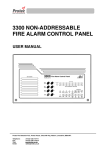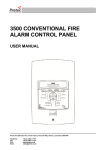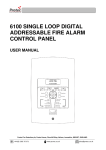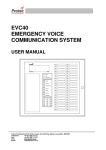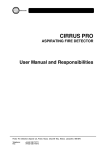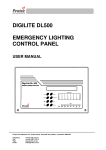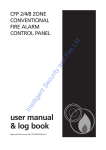Download 3200 User - Protec Fire Detection
Transcript
3200 NON-ADDRESSABLE FIRE ALARM CONTROL PANEL USER MANUAL Protec Fire Detection PLC, Protec House, Churchill Way, Nelson, Lancashire, BB9 6RT. Telephone: Fax: Web: Email: +44 (0) 1282 717171 +44 (0) 1282 717273 www.protec.co.uk [email protected] Document Revision Details Issue 0 Modification Detail Document Creation 93-330-72 Issue 0 Page 2 of 20 Author Date NH 23/06/05 © Protec Fire Detection PLC 2005 Table of Contents 1.0 INTRODUCTION ..................................................................................................................................................... 4 2.0 USER RESPONSIBILITIES .................................................................................................................................... 5 2.1 3.0 ROUTINE TESTING OF THE SYSTEM. ................................................................................................................. 6 3.1 3.2 3.3 3.4 3.5 3.6 4.0 TESTING THE INDICATIONS (LAMP TEST) ......................................................................................................... 9 SYSTEM FIRE INDICATIONS ................................................................................................................................ 9 6.1 6.2 6.3 6.4 7.0 ACCESS LEVEL 1 (GENERAL USER).................................................................................................................. 7 ACCESS LEVEL 2 (AUTHORISED USER) ............................................................................................................ 7 INDICATIONS AND CONTROLS ........................................................................................................................... 8 5.1 6.0 DAILY INSPECTION .......................................................................................................................................... 6 WEEKLY TEST.................................................................................................................................................. 6 MONTHLY TEST ............................................................................................................................................... 6 QUARTERLY TEST ............................................................................................................................................ 6 ANNUAL TEST .................................................................................................................................................. 6 5 YEARLY TEST ............................................................................................................................................... 7 ACCESS LEVELS ................................................................................................................................................... 7 4.1 4.2 5.0 REQUIREMENTS OF THE APPOINTED RESPONSIBLE PERSON ............................................................................. 5 ‘GENERAL FIRE’ INDICATOR ILLUMINATED ..................................................................................................... 9 ‘MCP FIRE’ INDICATOR ILLUMINATED ............................................................................................................ 9 FIRE ZONES FLASHING ..................................................................................................................................... 9 FIRE ZONES STEADY ........................................................................................................................................ 9 FAULT INDICATIONS........................................................................................................................................... 10 7.1 7.2 7.3 7.4 7.5 ZONE FAULTS ................................................................................................................................................ 10 SYSTEM FAULTS ............................................................................................................................................ 10 ALARM FAULTS ............................................................................................................................................. 10 POWER SUPPLY FAULTS ................................................................................................................................. 10 AUX 24V. FAULT ........................................................................................................................................... 10 8.0 COINCIDENCE ZONES ........................................................................................................................................ 11 9.0 RESPONSE TO AN ALARM ................................................................................................................................. 12 9.1 9.2 9.3 9.4 9.5 9.6 10.0 SYSTEM DISABLEMENTS................................................................................................................................... 13 10.1 10.2 11.0 AUTOMATIC DETECTION ................................................................................................................................ 12 MANUAL DETECTION ..................................................................................................................................... 12 SILENCING THE ALARMS ................................................................................................................................ 12 RESETTING AFTER AN ALARM ....................................................................................................................... 12 NEW ZONE INTO ALARM ................................................................................................................................ 12 ACTIVATING THE ALARMS MANUALLY ......................................................................................................... 12 DISABLING DETECTOR ZONES ....................................................................................................................... 13 DISABLING ALARM OUTPUTS ........................................................................................................................ 14 TESTING DETECTION ZONES ............................................................................................................................ 15 11.1 PROGRAMMING A ZONE INTO TEST MODE ..................................................................................................... 15 APPENDIX 1 3200 SYSTEM SET-UP RECORD ....................................................................................................... 16 APPENDIX 2 3200 EVENT LOG ................................................................................................................................ 17 APPENDIX 2 3200 EVENT LOG ................................................................................................................................ 17 APPENDIX 3 3200 OPERATION QUICK REFERENCE GUIDE ................................................................................ 19 93-330-72 Issue 0 Page 3 of 20 © Protec Fire Detection PLC 2005 1.0 Introduction The Protec 3200 Fire Alarm Control Panel has been designed to comply with European Standards EN54 parts 2 and 4. The Protec 3200 is also capable of distinguishing between automatic (Detector) and manual (Call Point) zone activation. The panel takes the appropriate action based on the type of alarm activation. The Protec 3200 constantly monitors all detector and sounder circuits. The internal power supply regularly performs internal checks ensuring correct operation. The standby batteries are monitored for charge and condition. Any faults detected are reported via the front panel display. A fault output is provided for connection to external equipment. The Appendices of this manual include a system set up sheet and an example event log. The system set up sheet is completed by the commissioning engineer prior to system hand over. The system set up sheet details exactly how the system has been set up and programmed. It will probably be the only such record and should be kept in a safe place. The event log must be completed by the authorised user of the system whenever a Fire or Fault event occurs. It is advisable to make copies of the example event log to continue the log once the included sheet has been filled. Important Note: There are no user serviceable parts within the Protec 3200 panel. All internal maintenance work MUST be carried out by a competent person trained to undertake such work. A separate Installation, Commissioning and Maintenance Manual is available. This product has been manufactured in conformance with the requirements of all applicable EU council directives. 93-330-72 Issue 0 Page 4 of 20 © Protec Fire Detection PLC 2005 2.0 User Responsibilities The registered owner of the fire alarm system has specific responsibilities regarding the installation, testing and maintenance of the fire alarm system. BS5839 Pt 1: 2002 states that the owner of the fire alarm system must appoint a single, named, person to supervise all matters regarding the fire alarm system. The following is a brief summary of the appointed persons responsibilities. 2.1 Requirements of the Appointed Responsible Person • Check the fire alarm equipment at least every 24 hours ensuring there are no faults on the system or report any faults to the site maintenance manager. • Ensure that arrangements are in place for testing the fire alarm system as specified in BS5839 Pt 1 : 2002 Section 6. (Summarised in section 3.0 of this manual). • Ensure that the system event log is kept up to date and is available for inspection by any authorised person. An example event log is included in Appendix 2. • Ensure that all occupants of the protected premises are trained how to use the system properly and that they are aware of what action to take in the event of an alarm. • Ensure that false alarms are minimised. • Ensure all detectors and manual call points remain un-obstructed. Detectors must have at least 500mm clear space preserved in all directions around them. • Ensure that six spare manual call point frangible elements (glass fronts) and appropriate fitting tools are available as replacements for use in the event a manual call point is activated. Important Note: It is advised that a full copy of BS5839 Pt 1: 2002 is obtained and thoroughly read and understood. 93-330-72 Issue 0 Page 5 of 20 © Protec Fire Detection PLC 2005 3.0 Routine Testing of the System. Recommendations for testing of the system are detailed in BS5839 Pt 1: 2002 (Section 6). Routine testing is outlined below: 3.1 Daily Inspection • Check that the ‘Supply Present’ indicator is illuminated. • Check for any faults on the system and report these to the site maintenance manager. 3.2 Weekly Test • Perform an indicator test (Lamp Test) to check the integrity of the front panel indications, and internal buzzer. See Section 5.1 • Ensure no manual call points or detectors are obstructed. • Operate a manual call point or detector during normal working hours to ensure the fire alarm system operates correctly. See Section 11 if it is required to place the zone in ‘Test Mode’ for the duration of the test • A different manual call point or detector on a different zone should be tested each week, thus testing all the devices over a period of time. • Ensure the system sounders are operational. • Ensure the sounders are operated for a minimum amount of time during testing. Genuine alarms can then be distinguished by the occupants of the building. 3.3 Monthly Test • Perform the weekly test recommended in 3.2. • If an automatic generator is used as part of the mains failure back-up system it should be started up once each month by simulated failure of the normal power supply, and then run in this mode for at least 1 hour. • Visually inspect the stand-by batteries and their connections. Check that the batteries are capable of supplying the alarm sounders. 3.4 Quarterly Test • Perform the monthly test recommended in 3.3. • Ensure the system event log is up to date and correct. Check that all faults noted have been attended to. 3.5 • • Annual Test Perform the Quarterly test recommended in 3.4. Test every detector, manual call point and all auxiliary equipment for correct functionality. 93-330-72 Issue 0 Page 6 of 20 © Protec Fire Detection PLC 2005 3.6 • • 5 Yearly Test Perform the Annual test recommended in 3.5. Carry out a full wiring check in accordance with the testing and inspection requirements of the relevant National wiring regulations (I.E.E regulations for the UK). 4.0 Access Levels The 3200 has two access or authorisation levels for the user, allowing different functions. 4.1 Access Level 1 (General User) Access level 1 allows the general user to view the status at any time. Zone Fire and Fault states are displayed together with any current system faults or disablements. Details of the front panel display are given in Section 5. The following functions can be performed at Access Level 1. • • • 4.2 Muting the internal buzzer. Accepting current fire and fault conditions Entering the Access Level 2 code. Access Level 2 (Authorised User) Access level 2 allows the authorised user access to critical system functions. To enter access level 2 from access level 1: 1) On ‘Code Entry’ models – Enter the code 1 3 4 4 2 2) On ‘Key Switch’ models – Turn the key When the correct code has been entered, or the key-switch has been turned the ‘Level 2 Accessed’ indicator lights, showing that level 2 functions are available. To return back to access level 1, press button 4, or return the key-switch back to its normal position. NOTE: As a security measure ‘Code Entry’ models will leave level 2 if no key activity has been detected for 2 minutes. The following functions can be performed at access level 2. • • • • • • • Silencing an alarm condition. Sounding the alarms. Resetting the panel after an alarm activation. Testing the front panel indications and internal buzzer. Programming a zone into test mode. Disabling detector circuits. Disabling alarm circuits. 93-330-72 Issue 0 Page 7 of 20 © Protec Fire Detection PLC 2005 5.0 Indications and Controls A comprehensive front panel display enables the state of the 3200 to be rapidly determined by inspection of the indications. • Zone Fires are displayed on the indicators on the top left of the front panel. • Zone Fault Zone indicator flashing + ‘General Fault’ indicator, Zone Disabled Zone indicator steady + ‘General Disablement’ indicator and Zone in Test Zone indicator steady + ‘General Test’ indicator are all displayed on the top right of the front panel. • General Fire indications (automatic and MCP), Access Level, General Test and Alarms Silenced indications are given on row 3 of the display. • System Disablements and System Faults are displayed on row 4 of the front panel display. Zone Fire Indications Zone Fault (flashing) Disabled (steady) Test (steady) System Disablement Indications Push Buttons For: a) Code entry b) Lamp test c) Programming System Fault Indications Access level indications Figure 5.0 Front panel Indications and controls 93-330-72 Issue 0 Page 8 of 20 © Protec Fire Detection PLC 2005 5.1 Testing the Indications (Lamp Test) To test the functionality of the front panel indicators: 1. At access level 1 enter the 5 digit user code 1 3 4 4 2 or turn the key switch. The ‘Level 2 accessed’ indicator will light. 2. Press button ‘1’. The 3200 will light all its indicators and sound the internal buzzer. 3. Confirm that each indicator operates and that the buzzer can be heard clearly. Inform the site maintenance manager of any problem as soon as possible. 6.0 System Fire Indications The 3200 displays fire information on the upper left of the front panel display. 6.1 ‘General Fire’ Indicator Illuminated A Fire has been detected on a zone, or an activation has been detected from external equipment, via the ‘Remote Alarm’ input. The building fire plan should be executed immediately. 6.2 ‘MCP Fire’ Indicator Illuminated A manual call point has been activated on one of the detection zones. This will always be accompanied by the ‘General Fire’ indicator and the relevant zone indicator. 6.3 Fire Zones Flashing A Fire has been detected in the relevant zone. This will always be accompanied by the ‘General Fire’ indicator. 6.4 Fire Zones Steady A Fire has been detected in the relevant zone and has been accepted by a user pressing the ‘Mute Buzzer’ button. 93-330-72 Issue 0 Page 9 of 20 © Protec Fire Detection PLC 2005 7.0 Fault Indications When a fault is detected in the critical operating path of the system, it will display this on the front panel display. The internal buzzer will also pulse slowly. The ‘General Fault’ indicator will illuminate, together with some other indicator that details the fault. In general, fault indicators flash until the fault is accepted (pressing the ‘Mute Buzzer’ button), the fault indicator then lights steady and the internal buzzer is muted. Further faults reactivate the buzzer. In the event of any fault the following action should be taken: • • Mute the fault buzzer by pressing the ‘Mute Buzzer’ button on the panel. Note the fault down in the log book and take action to remedy the fault. In all cases expert advice should be sought. When the fault has been rectified the fault indicator will automatically extinguish. 7.1 Zone Faults Faults on the detection zones are shown on the upper right of the display. The ‘General Fault’ indicator will be illuminated accompanied by the relevant zone indicator. Pressing ‘Mute Buzzer’ mutes the buzzer but WILL NOT make the zone indicator go steady. 7.2 System Faults The 3200 performs many self tests to ensure the software is working correctly. The fault should be cleared by pressing ‘Silence Alarms’ then ‘Reset Panel’ whilst in access level 2. If the fault re-occurs with 3 minutes the 3200 has a microprocessor fault, and the maintenance manager must be alerted. 7.3 Alarm Faults A fault has been detected on one or more of the two sounder outputs. One or more of the sounder circuits may no longer operate correctly. 7.4 Power Supply Faults A fault has been detected in the power supply module. This may be due to a local mains supply failure or because the stand-by batteries or charger are faulty. 7.5 Aux 24V. Fault A fault has been detected with the Auxiliary 24V supply output of the panel. 93-330-72 Issue 0 Page 10 of 20 © Protec Fire Detection PLC 2005 8.0 Coincidence Zones During commissioning, detection zones may have been programmed as ‘coincidence’ zones. This means that both of the zones must activate before the alarms sound or the Global Fire Contacts activate. Manual Call Point activation on either zone overrides the coincidence programming. If one zone is triggered the cause of the activation must be investigated, if no action is taken within 2 minutes the alarms will sound and the Global Fire contacts will activate. If the cause of the alarm is deemed false, the 3200 should be reset. To determine if coincidence zones have been programmed into the system, consult the system set-up chart (Appendix 1). 93-330-72 Issue 0 Page 11 of 20 © Protec Fire Detection PLC 2005 9.0 Response To An Alarm 9.1 Automatic Detection If a Smoke or Heat Detector operates on a zone, it is known as an ‘Automatic Operation’. The 3200 responds by: • • • • • 9.2 Illuminating the ‘General Fire’ indicator. Flashing the relevant zone fire indicator. Fast pulsing the internal buzzer. Activating non-disabled alarm outputs. Activating the Global Fire contacts. Manual Detection If a Manual Call Point is operated on a zone, it is known as a ‘Manual Operation’. The 3200 responds by: • • • • • • • 9.3 Illuminating the ‘General Fire’ indicator. Illuminating the ‘MCP Fire’ indicator. Flashing the relevant zone fire indicator. Fast pulsing the internal buzzer. Activating non-disabled alarm outputs (immediately). Activating the Global Fire contacts. Re-sounding the alarms if the zone had a previously silenced automatic operation. Silencing the Alarms The alarms and internal buzzer are silenced by pressing ‘Silence Alarms’ in access level 2. 9.4 Resetting After an Alarm After the cause of the alarm has been determined (and entered in the log by the authorised user) the event is reset, if required. In access level 2, press ‘Silence Alarms’ then press ‘Reset Panel’. This resets any latched detectors on the zone connections. Manual Call Points must be reset manually. 9.5 New Zone into Alarm If a new zone goes into alarm or a previously silenced zone (triggered by an automatic device) has a manual activation, the alarms and the internal buzzer will re-sound. 9.6 Activating The Alarms Manually To evacuate the building press ‘Sound Alarms’ in access level 2. The alarm outputs will activate, but the Global Fire Contacts WILL NOT be activated. 93-330-72 Issue 0 Page 12 of 20 © Protec Fire Detection PLC 2005 10.0 System Disablements Various disablements can be programmed by the authorised user. In some situations it may be useful to ‘turn off’ certain functions to suit specific site conditions. The following disablements can be made by the authorised user, at access level 2. • Zone Disablements Fires and Faults from the disabled zone are inhibited. • Alarm Disablements Activations and Faults from the disabled alarm circuit are inhibited. 10.1 Disabling Detector Zones One or both of its detector zones can be disabled. When a zone is disabled both faults and activations are inhibited. 1. From access level 1 enter the 5 digit user code 1 3 4 4 2. The ‘Level 2 Accessed’ indicator will illuminate. 2. Press button 2 once – The ‘General Disablement’ indicator will illuminate to show the zone disablement option is selected (the normal front panel display is temporarily replaced with the programming display). Any current disablements will be displayed on the zone fire indicators. 3. Press button 1 (zone 1) or button 2 (zone 2) to toggle - disabled / not disabled. 4. Press button 4 to accept and program the disablement set-up and return to access level 2. 5. Press button 4 to return back to access level 1. The yellow ‘General Disablement’ indicator will be illuminated steady, together with the yellow disablement indicator for the relevant zone(s). Figure 10.0. Example of the display when disabling zone 1. 93-330-72 Issue 0 Page 13 of 20 © Protec Fire Detection PLC 2005 10.2 Disabling Alarm Outputs Both alarm circuits can be disabled. When alarm circuits are disabled both faults and activations are inhibited. Individual Alarm circuits cannot be disabled. 1. From access level 1 enter the 5 digit user code 1 3 4 4 2. The ‘Level 2 Accessed’ indicator will illuminate. 3. Press button 2 to enter programming mode, the 'General Disablement' indicator will illuminate. 4. Press button 3 until the 'Alarm Outputs' indicator lights. 5. Press button 1 to toggle the alarm circuits - disabled / not disabled. If the alarm circuit is disabled the zone 1 fire indicator will be illuminated. 6. Press button 4 to accept and program the disablement set-up and return to access level 2. 7. Press button 4 to return back to access level 1. The yellow ‘General Disablement’ indicator will be illuminated steady, together with the yellow ‘Alarm Outputs’ indicator. Figure 10.1. Example of the display when disabling the alarm outputs. 93-330-72 Issue 0 Page 14 of 20 © Protec Fire Detection PLC 2005 11.0 Testing Detection Zones To aid the required fire alarm test schedule, zones can be put into ‘test mode’. In this mode, an alarm on the test zone activates the alarm outputs for 4 seconds then automatically resets. This allows a zone of detectors to be tested without having to manually reset the panel after each activation. The Global Fire Contacts are not activated when the test zone goes into alarm. Alarms on non-test zones will prevent the automatic reset. 11.1 Programming a Zone into Test Mode The procedure for programming a zone into test is given below. 1. From access level 1 enter the 5 digit user code 1 3 4 4 2. The ‘Level 2 Accessed’ indicator will illuminate. 2. Press button 2 to enter programming mode, the 'General Disablement' indicator will illuminate. 3. Press button 3 until the 'General Test' indicator lights. Any zones currently in test mode will be displayed on the zone fire indicator. 4. Press button 1 (zone 1) or button 2 (zone 2) to toggle - test mode / not in test mode. 5. Press button 4 to accept and program the disablement set-up and return to access level 2. 6. Press button 4 to return back to access level 1. The yellow ‘General Test’ indicator will be illuminated steady, showing that at least one zone has been programmed into test mode. Any zones programmed into test mode will have their test indicator illuminated steady. Important Note: • Ensure zones are removed from test mode when testing of the system is complete. Figure 10.2. Example of display when programming zone 2 into test mode. 93-330-72 Issue 0 Page 15 of 20 © Protec Fire Detection PLC 2005 Appendix 1 3200 System Set-Up Record This sheet must be completed by the engineer in charge of commissioning the system. It is the only record of how the system has been configured and, as such, should be safely stored for future reference. ZONE ZONE DESCRIPTION / LOCATION PROGRAMMING CONNECTED TO RESULT 1 2 CONNECTION Global Fault Global Fire Class Change Remote Alarm COMMISSIONING DETAILS System Commissioned By: Date: Company: Contact Details: 93-330-72 Issue 0 Page 16 of 20 © Protec Fire Detection PLC 2005 Appendix 2 3200 Event Log The person appointed in charge of the fire alarm system should complete the relevant section of this sheet whenever an event (fire or fault) occurs on the system. Name of appointed responsible person………………………………………………………………………………. Contact details of above person……………………………………………………………………………………….. Contact details of maintenance person / company ………………………………………………………………………………………………………………………. ………………………………………………………………………………………………………………………. Fire Alarm System Event Log DATE TIME 93-330-72 Issue 0 ZONE DETAILS ACTION REQUIRED Page 17 of 20 COMPLETED NAME © Protec Fire Detection PLC 2005 Fire Alarm System Event Log (continued) DATE TIME 93-330-72 Issue 0 ZONE DETAILS ACTION REQUIRED Page 18 of 20 COMPLETED NAME © Protec Fire Detection PLC 2005 Appendix 3 3200 Operation Quick Reference Guide 14.1 Muting the Internal Buzzer • Press ‘Mute Buzzer’ 14.2 Entering Access Level 2 • Enter the 5 digit user code 1 3 4 4 2. The ‘Level 2 Accessed’ indicator lights. 14.3 Silencing the Alarms • From access level 2 press ‘Silence Alarms’. A further activation will re-sound the alarms. 14.4 Sounding the Alarms • From access level 2 press ‘Sound Alarms’. 14.5 Resetting the Panel • Determine the cause of the alarm before resetting the panel • From access level 2 press ‘Silence Alarms’ then press ‘Reset Panel’. 14.6 Testing the Indicators and Internal Buzzer • From access level 2 press button ‘1’. 93-330-72 Issue 0 Page 19 of 20 © Protec Fire Detection PLC 2005 Protec Fire Detection PLC, Protec House, Churchill Way, Nelson, Lancashire, BB9 6RT. Telephone: Fax: Web: Email: +44 (0) 1282 717171 +44 (0) 1282 717273 www.protec.co.uk [email protected] 93-330-72 Issue 0 Page 20 of 20 © Protec Fire Detection PLC 2005




















